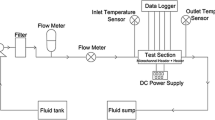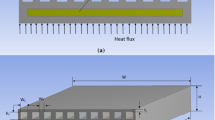Abstract
Microchannel heat sinks (MCHS) have been gaining demand in electronic industry because of size and performance. Electronic chips produce more temperatures and these temperatures have to be eliminated to avoid failure of electronic chips. MCHS shows higher heat transfer rates, however, with a penalty of pressure drop. In this work, the influence of variation in cross-sectional area on the thermohydraulic characteristics at a constant heat flux of 80 W/cm2 for MCHS has been studied. Grid independence study has been studied. Five different cross-sectional areas ranging from 0.12 mm2 to 0.20 mm2 have been considered for computational investigation. Friction factor, pressure drop have been considered to evaluate hydraulic characteristics and cooling capacity, and temperature difference have considered to evaluate thermal characteristics.
Access provided by Autonomous University of Puebla. Download conference paper PDF
Similar content being viewed by others
Keywords
Introduction
Electronic devices have become much faster, smaller, and very powerful because of enhancements in technology. Because of raise in temperatures, the performance is reducing in electronic devices. The large integration of electronic components and the raise in voltage–current managing have led to high accumulation of heat in such devices. The heat elimination or rejection has become a major factor, which constraints the electronic product’s development. Hence, to increase the life span and performance of electronic chips, heat management has become crucial.
Most of the authors has did their work on thermal characteristics of fluid by using air as cooling fluid to remove heat from the electronic chips. However, when it comes to dealing with such parts, which contains a huge number of transistors, which are working at high frequency. The temperatures of chips will reach to a point where normal cooling process is not enough. MCHS showing better performance in terms of removing higher temperatures. Recently, [1] has studied on the microchannel heat sink with annular flow through it, [2] has proposed microchannel heat sink with an unique structure of rhombus fractal like structure, [3] has proposed transverse microchannels to the main channels, [4] has added cavities and fins to the MCHS, [5] has passed cryogenic fluid through microchannel heat exchangers, [6] has passed nanofluids through the MCHS, [7] has worked on different shapes of MCHS, and [8] has considered three different shapes and different aspect ratios. In this work, the variation in cross-sectional areas has been investigated at a constant heat flux of 80 W/cm2 for different Reynolds numbers ranging from 200 to 1000 for a rectangular MCHS at an aspect ratio (α = Hch/Wch) of 11.442. Five different cross-sectional areas are 0.12 mm2, 0.14 mm2, 0.16 mm2, 0.18 mm2, and 0.20 mm2, with widths 0.102 mm, 0.110 mm, 0.118 mm, 0.125 mm, and 0.132 mm, respectively. Water has considered as flow fluid and copper has considered as substrate. The schematic diagram of MCHS has drawn in ANSYS 14.5 as shown in Fig. 66.1.
Mathematical Formulation
To find the thermal and hydraulic characteristics of microchannel heat sinks (MCHS) and for solving heat transfer problems, the following assumptions are made.
-
1.
The fluid poses laminar characteristics.
-
2.
The fluid is incompressible and in steady-state condition.
-
3.
At walls of the fluid, zero slip boundary condition is assumed.
-
4.
The impact of gravity and radiation heat transfer are assumed to be negligible.
-
5.
Properties of the solid and fluid are assumed as constant except the viscosity of coolant water (viscosity of fluid varies with fluid temperature).
-
6.
The influence of viscous dissipation of fluid flow is negligible.
-
7.
The governing equations for the fluid and solid are modified to evaluate the thermal and hydraulic characteristics of MCHS [8].
Conservation of mass,
Conservation of momentum,
Conservation of energy,
For the solid region, the energy equation is as follows,
where \({\vec{\mathbf{V}}}\) is velocity vector, \(\mu_{fd}\) is dynamic viscosity of fluid, \(\rho_{fd}\) is density of fluid, \(k_{fd}\) is thermal conductivity of fluid, P is pressure, \(k_{sd}\) is thermal conductivity of fluid, Tfd is temperature of channel, and Tsd is temperature of solid.
To calculate hydraulic diameter for rectangular microchannel,
where AC is cross-sectional area of channel, Pch is perimeter of channel, Hch is height of channel, and Wch is width of channel.
The velocity can be obtained from,
where ρfd is density of fluid, Dh is hydraulic diameter, v is velocity of fluid, and µfd is dynamic viscosity of fluid. The mass flow rate of fluid can be calculated from [9],
where \(\dot{m}\) is mass flow rate of fluid and AC is cross-sectional area of fluid. From post-processing module, the shear stress (τwall) can be obtained to calculate the friction factor. The friction factor can be estimated from,
where fr is friction factor and τwall is shear stress.
The convective heat transfer coefficient can be calculated from,
where hc is convective heat transfer coefficient, Q is heat transfer, Asrf is surface area, Twall is wall temperature of fluid, and Tbulk = (Tinlet + Toutlet)/2 is bulk temperature of fluid.
The cooling capacity of fluid can be estimated from,
where Qcc is cooling capacity of fluid, cpf is specific heat of fluid, Toutlet is outlet temperature of fluid, Tinlet is inlet temperature of fluid, and \(\dot{V}\) is volume flow rate.
The temperature difference of fluid can be calculated by,
Results and Discussion
Grid independence study has been done and considered one mesh size for further simulations. Hydraulic characteristics and thermal characteristics of the MCHS have been studied.
Grid Independence Test
To maintain the accuracy in results, a grid independence study was studied on the microchannel. The obtaining results are sensitive to the mesh size; hence, the variation in the mesh size leads to the variation in result. However, at some point, the variation in values would be very small to consider that mesh would be suitable for simulation to obtain more accurate results.
In this work, six different cases have been considered for grid independence test as shown in Fig. 66.2 and the description of mesh body is as given in Table 66.1. The percentage difference of velocity at outlet are 2.34%, 0.15%, 0.36%, 0.13%, and 0.09%. While the percentage of difference in temperature are 0.055%, 0.051%, 0.054%, 0.013%, and 0.002%. Among the six different cases, percentage difference is very small for case 5 and case 6. Hence, case 5 has considered for simulations.
Hydraulic Characteristics
Friction factor and pressure drop have been considered for investigation. The characteristics were investigated with respect to Reynolds number.
The variation of friction factor with respect to Reynolds number is shown in Fig. 66.3. The variation of friction factor among the five cross-sectional areas is minor. However, as the Reynolds number increases, friction factor decreases. At Reynolds number 200, the friction factor is higher and for Reynolds number 1000, the friction factor is lower. Considering the higher Reynolds number which leads to the lower friction factor.
Figure 66.4 shows the variation of pressure drop with respect to Reynolds number. As the Reynolds number increases, pressure drop also increases. Cross-sectional area 0.12 mm2 shows high pressure drop among five different cross-sectional areas. At Reynolds number 200, the pressure drop is lower and for Reynolds number 1000, the pressure drop is higher. Higher Reynolds number leads to the pressure drop.
Thermal Characteristics
Figure 66.5 shows the variation of cooling capacity with respect to Reynolds number. As the Reynolds number increases, cooling capacity also increases. Cross-sectional area 0.20 mm2 shows higher cooling capacity among five different cross-sectional areas. At Reynolds number 200, the cooling capacity is lower and for Reynolds number 1000, the cooling capacity is higher. Higher Reynolds number leads to the higher cooling capacity.
Figure 66.6 shows the variation of temperature difference with respect to Reynolds number. As the Reynolds number increases, temperature difference decreases. Cross-sectional area 0.12 mm2 shows higher temperature difference among five different cross-sectional areas. At Reynolds number 200, the temperature difference is higher and for Reynolds number 1000, the cooling capacity is lower. Lower Reynolds number leads to the higher temperature difference.
Conclusion
The influence of variation in cross-sectional area ranging from 0.20 mm2 to 0.12 mm2 has been investigated. Hydraulic and thermal characteristics have been calculated and the conclusions have been made. Higher Reynolds number is preferable to reduce the friction factor and there is very small variation in friction factor among five different cross sections. Larger cross-sectional area poses least pressure drop among the cross-sectional areas. For cooling capacity, larger cross-sectional area poses higher cooling capacity.
References
Liu H, Qi D, Shao X, Wang W (2019) An experimental and numerical investigation of heat transfer enhancement in annular microchannel heat sinks. Int J Therm Sci 142(March):106–120. https://doi.org/10.1016/j.ijthermalsci.2019.04.006
Zhuang D, Yang Y, Ding G, Du X, Hu Z (2020) Optimization of Microchannel Heat Sink with Rhombus Fractal-like Units for Electronic Chip Cooling. Int J Refrig 116:108–118. https://doi.org/10.1016/j.ijrefrig.2020.03.026
S. Soleimanikutanaei, E. Ghasemisahebi, and C. Lin, “Numerical study of heat transfer enhancement using transverse microchannels in a heat sink,” Int. J. Therm. Sci., vol. 125, no. July 2017, pp. 89–100, 2018, doi: https://doi.org/10.1016/j.ijthermalsci.2017.11.009.
Y. Li, Z. Wang, J. Yang, and H. Liu, “Thermal and hydraulic characteristics of microchannel heat sinks with cavities and fins based on field synergy and thermodynamic analysis,” Appl. Therm. Eng., vol. 175, no. April, p. 115348, 2020, doi: https://doi.org/10.1016/j.applthermaleng.2020.115348.
Dondapati RS, Saini V, Verma KN, Usurumarti PR (2017) Computational prediction of pressure drop and heat transfer with cryogen based nanofluids to be used in micro-heat exchangers. Int J Mech Sci 130:133–142. https://doi.org/10.1016/j.ijmecsci.2017.06.012
V. A. Martínez, D. A. Vasco, C. M. García-herrera, and R. Ortega-aguilera, “Numerical study of TiO2 -based nanofluids flow in microchannel heat sinks : Effect of the Reynolds number and the microchannel height,” Appl. Therm. Eng., vol. 161, no. June, p. 114130, 2019, doi: https://doi.org/10.1016/j.applthermaleng.2019.114130.
Gunnasegaran P, Mohammed HA, Shuaib NH, Saidur R (2010) The effect of geometrical parameters on heat transfer characteristics of microchannels heat sink with different shapes. Int Commun Heat Mass Transf 37(8):1078–1086. https://doi.org/10.1016/j.icheatmasstransfer.2010.06.014
Wang H, Chen Z, Gao J (2016) Influence of geometric parameters on flow and heat transfer performance of micro-channel heat sinks. Appl Therm Eng 107:870–879. https://doi.org/10.1016/j.applthermaleng.2016.07.039
Dondapati RS, Rao VV (2013) Pressure Drop and Heat Transfer Analysis of Long Length Internally Cooled HTS Cables. IEEE Trans Appl Supercond 23(3):2–5
Author information
Authors and Affiliations
Corresponding author
Editor information
Editors and Affiliations
Rights and permissions
Copyright information
© 2023 The Author(s), under exclusive license to Springer Nature Singapore Pte Ltd.
About this paper
Cite this paper
Tiruveedula, M.S., Gadekula, R.K., Dondapati, R.S. (2023). Thermohydraulic Characteristics of Microchannel Heat Sinks Used in Electronic Cooling Applications. In: Manik, G., Kalia, S., Verma, O.P., Sharma, T.K. (eds) Recent Advances in Mechanical Engineering. Lecture Notes in Mechanical Engineering. Springer, Singapore. https://doi.org/10.1007/978-981-19-2188-9_66
Download citation
DOI: https://doi.org/10.1007/978-981-19-2188-9_66
Published:
Publisher Name: Springer, Singapore
Print ISBN: 978-981-19-2187-2
Online ISBN: 978-981-19-2188-9
eBook Packages: EngineeringEngineering (R0)










